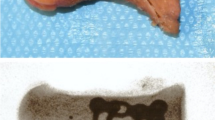Abstract
The mechanical stability of proximal femoral osteotomies fixed by the tension band wire technique was studied in flexion-compression and torsion tests. The fixation consisted in crossing the section with two Kirschner wires and with a wire cerclage applied to the tension surface. The study was conducted in three steps. First, cyclinders of wood were cut either transversely or at 30° of inclination in relation to the long axis of the specimen, and fixed with two Kirschner wires and a wire cerclage. We concluded that the inclination of the plane of section significantly increased the stability of fixation. No significant difference was observed when oblique sections were made in the reverse orientation. Second, 30° subtrochanteric varus osteotomies were performed in dog femurs, so that the section plane was transverse in one group and oblique in another, after closing the osteotomy. In both groups the fixation was achieved by two Kirschner wires that crossed the osteotomy and a wire cerclage placed on the lateral cortex (tension surface). We concluded that inclination of the osteotomy plane increased the stability of osteosynthesis in bone specimens, as already seen with the wood pieces. Third, the stability of tension band wire fixation was compared with that provided by the AO/ASIF paediatric angled plate. Varus osteotomies (30°) were created at the subtrochanteric level of paired dog femurs. On one side, the femur was fixed with Kirschner wires and a wire cerclage as described previously. For the other femur, the osteotomy was fixed with the angled plate. We found that both types of fixation presented the same stability in flexion-compression tests. However, under torsion the tension band wire fixation was 30%–50% less stable than the plate fixation.
Similar content being viewed by others
References
Beauchesne R, Miller F, Moseley C (1982) Proximal femoral osteotomy using the AO fixed-angle blade plate. J Pediatr Orthop 12:735–740
Brunner CF, Weber BG (1982) Special technics in internal fixation. Springer, Berlin, pp 102–104
Canale AT, Holand RW (1983) Coventry screw fixation about the pediatric hip. J Pediatr Orthop 3:592–600
Cordes S, Dickens DRV, Cole WG (1991) Correction of coxa vara in childhood. The use of Pauwels Y-shaped osteotomy. J Bone Joint Surg [Br] 73:3–6
Grundnes O, Reikerås O (1991) Mechanical effects of function on bone healing: nonweight bearing and exercise in osteotomized rats. Acta Orthop Scand 62:163–165
Grundnes O, Reikerås O (1993) Effect of instability on bone healing: femoral osteotomies studied in rats. Acta Orthop Scand 64:55–58
Legal H (1987) Introduction to the biomechanics of the hip. In: Tönnis D (ed) Congenital dysplasia and dislocation of the hip. Springer, Berlin, pp 26–57
Mølster AO (1984) Effects of rotational instability on healing of femoral osteotomies in the rat. Acta Orthop Scand 55:632–636
Mølster AO, Gjerdet NR (1984) Effects of instability on fracture healing in the rat. Acta Orthop Scand 55:342–346
Müller ME, Allgöwer M, Schneider R, Willenegger H (1991) Manual of internal fixation. Springer, Berlin, pp 252–269
Paccola CAJ, Freitas MB, Gaiga AF, Louzada RM, Moro CA (1987) Tirante de tensão. Estudo experimental da posição ideal. Rev Bras Ortop 22:217–222
Pauwels F (1990) Biomechanics of the locomotor apparatus. Springer, Berlin
Tachdjian MO (1990) Pediatric orthopedics. Saunders, Philadelphia, pp 392–395
Terjesen T, Svenningsen S (1988) The effects of function and fixation stiffness on experimental bone healing. Acta Orthop Scand 59:712–715
Volpon JB (1993) Fixação de osteotomias do terço proximal do fêmur da criança. Resenha Ortopédica 1:8–9
Wagner H (1978) Femoral osteotomies for congenital hip dislocation. In: Weil UH (ed) Progress in orthopedic surgery, Vol 2. Springer, Heidelberg, pp 85–105
Weber BG (1975) Zugurtungsosteosynthese mit Draht. Chirurg 46:102–105
Weightman B (1977) Stress analysis. In: Swanson SAV, Freeman MAR (eds) Scientific basis of joint replacement. Pitman Medical, London, pp 18–32
Author information
Authors and Affiliations
Rights and permissions
About this article
Cite this article
Engel, E.E., Volpon, J.B. & Shimano, A.C. Mechanical testing of the tension band wire fixation in the proximal femur. Arch Orthop Trauma Surg 116, 266–270 (1997). https://doi.org/10.1007/BF00390050
Received:
Issue Date:
DOI: https://doi.org/10.1007/BF00390050




